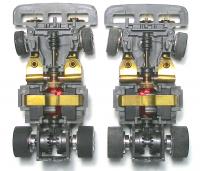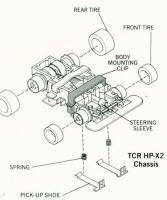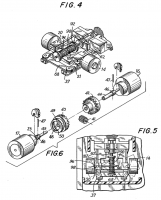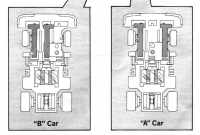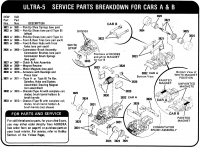TCR Guides: How Does It Steer?
How Does It Steer?
By Terry “Stumpy” Stone
One of the mysteries of Slotless racing for me was how do these cars steer? A conventional automobile steering system has spindles or “steering knuckles” at each end of a tie rod, which links both spindles together. Attached to each of these spindles were the right or left front wheels.
To make the wheels steer right or left there was a steering link (known as a “drag link”) which connected the tie rod system to a steering gear box, which was turned left or right by the steering wheel. Radio Control cars use basically the same system, but with an electrical servo instead of a steering box. Actually, it is a simple mechanical movement.
When I started looking at how slotless HO race cars worked, there was little that looked like either real or R/C cars. There was a differential type rear gear set up, a miniature version of what all road automobiles have, and there was the tie rod with spindles which linked the steering of the front wheels. But there was no steering gearbox or servo to move the front steering.
There WAS an odd worm gear mounted to the front motor shaft of the Aurora Speedsteer cars and a silicone sleeve mounted the same way in the Tyco TCR cars. But how did that turn the wheels left or right while the motor ran? If the motor turned clockwise, the worm gear or sleeve would be turning the same direction all the time, so why were they attached to the motor shaft and how could they steer the car in different directions? And why, of all the HO slot cars I had raced was a differential rear end necessary? After all, just like most real race cars I was familiar with, you “locked the rear end” so that both wheels drove the car all the time for maximum traction.
Bob Molta of Slot Car Central pointed me to the answer, and Dan at Tyco TCR Racing had reprinted the original slotless patents on his website. I read the patents for the Aurora Ultra Five and Speedsteer cars first, since the later Tyco TCR cars are a modified Speedsteer design.Have you ever read a patent? To say the writing is “dry” would be an understatement! I’ve seldom read anything so boring. But the answer was right there, and was incredibly simple!
The Ultra 5 cars were very much like the Speedsteer cars in concept, but used an electrical coil (solenoid) to steer the car. By reversing the polarity of the electricity going to the car, the solenoid shifted the tie rod left or right to steer the car. Dioides allow electricity to “flow” in only one direction, so the motor could only run forward, no matter which way the electrical polarity ran. That made sense to me, but didn’t really solve the mystery of the Speedsteer and TCR cars.
According to the patents for the Aurora Speedsteer system, the solenoid steering coil was heavy and caused the cars to spin out too often, and was complicated and somewhat costly to manufacture. The next system was lighter, less complex, and cheaper to manufacture. And once explained, I checked out what was happening by observing a chassis in operation at slower speed. It was so unbelievably simple!
The differential and the steering system are both necessary because the MOTOR CHANGES DIRECTION IN A SPLIT SECOND when you change the direction on the controller! The steering worm gear turns one way, moving a tiny wire connected to the right front spindle in one direction, and when the motor turns the other way, the worm gear turns in the other direction pulling the wire and turning the front wheels in the opposite direction. Tyco changed this to a silicone sleeve rolling back and forth on the tie rod itself. Simpler and cheaper, but less effective in use.
But wait a moment! Why doesn’t the car back up when you change motor direction to change lanes? Well, the differential gearing on the rear axle has two “crown” gears, one on the left side of the rear axle and one on the right side. When the motor changes direction it drives one crown gear at a time and the other “coasts.” When the motor rotation is changed, it engages the other crown gear and the first one coasts, so the car always moves forward, despite which direction the motor is turning! There are tiny pins in the rear axle that only engage by centrifugal force when the motor direction changes, and they lock or unlock one crown gear or the other as necessary.
Electrically the two race cars have the pick up shoes set to take power from either the two outside pick up rails (we’ll call the “A” car) or one outside and one center pick up rails (we’ll call the “B” car.) In this way, each controller only sends power to the car with the correct arrangement of pick up shoes.
The trigger on the controller is a reostat with windings to feed more or less power to the track for each car.
The trigger on the controller is a reostat with windings to feed more or less power to the track for each car. When you turn the lane changing wheel or switch, this instantly changes the polarity of the power to the motor causing it to turn in the other direction which makes the car change lanes. To keep from causing a short circuit there is a space between each pole of the direction switch where no power goes to the track. This “dead spot” is why the car won’t run at all unless the controller is turned one way or the other.
The Jam Car or Road Blocker Car take power from both lanes when at least one or both the race cars is running and are electrically isolated with diodes not to short and to keep their motors running the forward direction. (Interestingly, in their patents Ideal originally called theirs a Drone Car and a Wandering Drone Car.)
And so, mystery solved, and I’m slapping my hand on the side of my head wondering why I didn’t figure it out on my own? And then it hit me: I’m used to race cars where the engine or motor always turns in a single direction and has nothing to do with steering the car! The guys at Aurora who first designed this type of system must have been masters of “thinking outside the box!”


